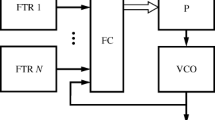The article discusses the subject of generation and keeping of time scales. The frequency of intragroup monitoring of the rate of hydrogen masers is singled out as one of the factors affecting the reliability of the generation of the time scale. A new algorithm for the generation of an analytical and physical time scale for a group of hydrogen masers is proposed, based on increasing the frequency of intragroup monitoring for the course of hydrogen standards. Using this algorithm, the identification and compensation time for the variations in the rate of individual hydrogen standards was reduced from 1 day to several minutes. The analytical group time scale formed in accordance with the algorithm proposed provides detailed information about the variations in the rate of individual hydrogen standards during the day. It was revealed that variations in the rate of separate hydrogen standards and the error of the time-interval counters contribute to the instability of the physical time scale. On the Russian State primary standard of units of time, frequency, and national time scale GET 1-2022, it was experimentally confirmed that by increasing the frequency of intragroup monitoring in accordance with the new algorithm, the instability of the time scale formed for a time interval of observation >1 h is reduced.





Similar content being viewed by others
Notes
The hydrogen standard is a physical device that is a measure of both frequency and time (clock).
HROG ― High Resolution Off set Generator. The model Spectra Dynamics HROG-5 was used in the work.
References
W. Allan David, H. Shoaf John, and Halfordt Donald, Time and Frequency: Theory and Fundamentals, Chapter 8. Statistics of Time and Frequency Data Analysis, Nat. Bur. Stand. (U.S.), Monogr., 140, 151–204 (1974), available at: https://nvl-pubs.nist.gov/nistpubs/Legacy/MONO/nbsmonograph140.pdf (accessed: 30.09.2022).
I. B. Norets, Reference base of GSVCH. Current state and development prospects, Alman. Modern Metrol., No. 8, 53–74 (2016).
N. B. Koshelyaevsky and O. Yu. Sokolova, An ensemble of clocks based on H-masers as a means of storing the national size of a unit of time and forming a national time scale, Reports of the VII Int. Symp. “Metrology of Time and Space”, 112–129 (2015).
S. Yu. Antropov, E. Yu. Glazov, A. A. Karaush, N. G. Maksimovich, D. S. Migunov, A. V. Naumov, I. B. Norets, Yu. F. Smirnov, V. Yu. Sobolev, and L. V. Schmidt, Algorithm for the formation of time scales for GSVCH standards, Metrology of Time and Space. Proc. X Int. Symp., pp. 38–39 (2021).
I. Yu. Blinov, A. L. Kapitonov, and Yu. F. Smirnov, Implementation of the national time scale UTC (SU) and its transfer to the GLONASS ground control complex, Alman. Modern Metrol., No. 1, 65–74 (2014).
S. N. Kagan, Yu. F. Smirnov, and I. Yu. Blinov, Complex for the formation and transmission of the national coordinated time scale UTC(SU) to the GLONASS center, Eighth All-Russian Scientific and Technical Conference “Metrological Support of Defense and Security in the Russian Federation,” p. 96 (2010).
Y. F. Smirnov, Meas. Tech., 50, No. 3, 293–297 (2007), https://doi.org/10.1007/s11018-007-0064-9.
D. V. Sutyrin, S. Y. Antropov, R. I. Balaev, et al., Quant. Electron., 49, No. 2, 199–204 (2019), https://doi.org/10.1070/QEL16885.
G. Panfilo, A. Harmegnies, and L. Tisserand, Metrologia, 49, No. 1, 49–56 (2012), https://doi.org/10.1088/0026-1394/49/1/008.
A. Bauch, S. Weyers, E. Staliuniene, D. Piester, and W. Yang, Metrologia, 49, 180–188 (2012), https://doi.org/10.1088/0026-1394/49/3/180.
W. J. Riley, Handbook of Frequency Stability Analysis, NIST Special Publication 1065 (July 2008), 14–18, available at: https://tsapps.nist.gov/publication/get_pdf.cfm?pub_id=50505 (accessed: 30.09.2022).
Measures for Random Instabilities in Frequency and Time (Phase). Recommendation ITU-R TF.538-4 (07/2017), available at: https://www.itu.int/rec/R-REC-TF.538-4-201707-I/en (accessed: 30.09.2022).
Author information
Authors and Affiliations
Corresponding author
Additional information
Translated from Izmeritel’naya Tekhnika, No. 11, pp. 44–50, November, 2022.
Rights and permissions
Springer Nature or its licensor (e.g. a society or other partner) holds exclusive rights to this article under a publishing agreement with the author(s) or other rightsholder(s); author self-archiving of the accepted manuscript version of this article is solely governed by the terms of such publishing agreement and applicable law.
About this article
Cite this article
Antropov, S.Y., Glazov, E.Y., Naumov, A.V. et al. Improving the Efficiency of Control and Reliability of Time Scale Generation for a Group of Hydrogen Time and Frequency Standards. Meas Tech 65, 834–840 (2023). https://doi.org/10.1007/s11018-023-02158-0
Received:
Accepted:
Published:
Issue Date:
DOI: https://doi.org/10.1007/s11018-023-02158-0




